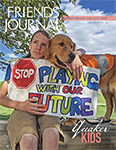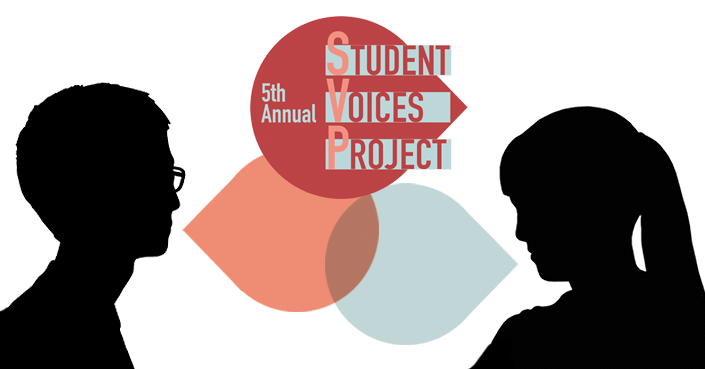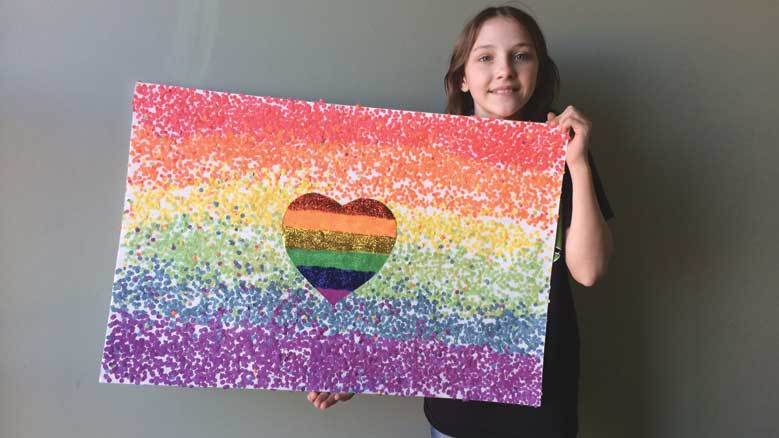Student Voices Project
The seventh annual Student Voices Project is underway! This year we’re asking students to write about creating change in their communities. As in past years, we welcome submissions from all middle school and high school students (Quaker and non-Quaker) at Friends schools as well as from Quaker students in other educational venues, such as public schools and homeschooling.
2019–2020 Theme: Creating Change
Positive change in a community is dependent upon individuals speaking up, coming together around a shared goal, and making a plan for action. Quakers have a long history of organizing for change in response to various social, economic, racial, and environmental injustices; most often this change begins with community members working together at the local level. Go to the project webpage (friendsjournal.org/studentvoices) for examples of Quakers who have helped create change in history and today, including a curated list of QuakerSpeak videos about activism.
Prompt: Write about creating change in your local community. (Visit the project webpage for a list of suggested advices and queries to consider.)
Submission Guidelines
- One submission per student.
- Must have an original title, and it must be typed.
- Word count: between 300 and 1,500 words.
- Submit individual entries via Submittable (link on our website).
Deadline: February 10, 2020
Instructions and details can be found at Friendsjournal.org/studentvoices
The spirit of God in all living things
As a small farmer, I agree with Stanley Chagala Ngesa’s ancestors that plants’ being is much the same as humans’ and other animals (“Quaker Christianity in Kenya,” FJ Oct.). I can sense when my tomatoes are struggling or when the beans are happy climbing their poles. When plants are tired, I give them extra water and some kelp and fish food. We prune and harvest to encourage growth. We feed and protect them, just as we might feed and protect chickens, sheep, goats, pigs, and cattle.
The world is a whole living unit. Even the rocks have being—they just move a lot slower! I have walked the slopes of volcanoes, studied geology, delighted in plate tectonics, as it explained much of the planet’s history.
The same Holy Spirit pervades it all. Mungu Ibariki.
Sandy Farley
Redwood City, Calif.
I also feel there is the Spirit of God in all living things, and indeed in all the natural environments themselves. I see Jesus as a great teacher of this relationship between human, nature, and God. He is the greatest teacher for me. So I would call myself a Christocentric Friend, who is open to every source of truth, love, and wisdom, and I am also comfortable with Universalist Friends and the communities who use programmed worship in Friends Churches.
Your story illustrates for me what is also true in Indigenous culture in Australia. For them, everything is filled with its own Spirit—the plants, animals, places, rivers, rocks . . . and is to be respected and honored always. I have a great respect for these people’s faith and close relationship with the land and creatures.
Helen Bayes
Victoria, Australia
Investment as a game of chance?
I really enjoyed the latest issue of Friends Journal on gambling (FJ Nov.). After becoming a Quaker, I have attempted to take that old-fashioned testimony seriously. I quit my friendly Friday poker game and I haven’t purchased a lottery ticket in decades. How I use the resources granted to me is a serious business and gambling isn’t a part. But I was dismayed that the authors of the articles confused gambling with investing. The two couldn’t be further apart.
Investing is becoming part of a productive enterprise—assuming it a socially responsible business. You are investing money in hopes that the management of the company will deliver a product or service that satisfies a consumer desire—thus earning a profit on the investment. Those profits are then returned to the investor for being part of the productive arrangement of a market economy. And, of course, there is the practical side of investing: almost everyone—Quakers included—plans for college or retirement by turning savings into investments.
David Ciscel
Memphis, Tenn.
I have long viewed gambling as a behavior that can lead to an addiction. In general, our society is addicted to competition, and to scenarios that foster the production of winners and losers.
Gambling is only one form of our worship of competition. Competitive sporting events are “cash cows” that pay out “big bucks” for just a few. People often gamble on the outcomes of sporting events. For a long time, I have promoted the use of collaborative strategies for conflict resolution. This approach aims toward creating win-win situations whenever possible.
Brian Humphrey
Wilton Manors, Fla.
Facing our histories
How wonderful it is to know the truth, especially about the Quakers involvement in slave trade and how the race supremacy started (“Slavery in the Quaker World” by Katharine Gerbner, FJ Sept.). It is written, “You shall know the truth, and the truth shall set you free.” Probably free from all the present world hypocrisies. Thank you for a highly informative essay.
Fidelia Onyuku-Opukiri
London, UK
That Quakers, even those of us who find agreement with George Fox’s revelation, should have a hard time overcoming their love of making money is not surprising, and definitely slavery was and is about making money. That that other person is a human, equal in God’s sight to ourselves, is therefore a hard thing to accept. That such acceptance did finally come is a wonder, after all. Wilberforce, Lay, Woolman, Cuffee, Dred Scott, and Frederick Douglas all must be remembered and studied. Martin Luther King Jr. said it well, “they will not be judged by the color of their skin but by the content of their character.” I had never considered the idea of “Protestant Supremacy.” But Gerbner teased it out of the records.
James Lehman
Sandy Spring, Md.
Wendy Warren’s New England Bound taught me that whether or not my colonial ancestors held slaves, they profited from the Atlantic slave trade. Perhaps, they grew crops or fished to feed the slaves of Barbados. (Most food was imported. The sugar crop was much too precious to devote any of the land to food.) Perhaps they built ships to move enslaved people between New England and the islands. Perhaps they lent money to ambitious farmers or sailors to increase their yields.
Those Philadelphia Quakers in 1688 knew that the mercantile system, based on the unpaid labor of enslaved people, worked quite well for everyone else. They could not honestly afford to tamper with success. Reparations are certainly necessary, and they will not negate our historical complicity.
Cossy Ksander
Oak Park, Ill.
It occurs to me, reading Gerbner’s essay, that Benjamin Lay (subject of a recent biography by Marcus Rediker) seems to have been radicalized about slavery over several years in Barbados. I was surprised that Lay himself went to Barbados in the first place, given its centrality in slave-based sugar production. Learning that Barbados was a haven for Quakers helped me put that piece in place. That Lay was as disappointed in Philadelphia’s slave-owning Friends as he had been in Barbadian Friends becomes clearer also.
Sharon Ann Holt
Trenton, N.J.
I thank Katharine Gerbner for her recent article but invite her to go deeper in exploring the interplay between religion, race, color, culture, and slavery. An excellent starting point would be to read (or reread) Princeton’s Professor Emerita Nell Irvin Painter’s The History of White People. She details over 2,000 years of the shifting constructions in the invention of race theory and domination. It is also significant that the religion-race dynamic was variously expressed in different colonies. Roman Catholicism encouraged baptizing slaves as soon as they were brought to the New World. I have seen a site in Haiti where a church once stood where slaves were taken for forced conversion and then immediately sold in the plaza in front. Lastly, we must not forget that many White Quakers who did not own slaves nevertheless built their wealth, as merchants and shippers, on the institution; too often early meetinghouses, schools, and other properties were linked to enslavement.
Adele Smith-Penniman
Wendell, Mass.
I am so grateful for this article, yet I want to lift up the many American Quakers of African descent who have been ministering to us White Friends for years about racism and White supremacy among us. Why does it take a White person, a scholar, to tell us (White people) the same history—and even more recent racist events— that Friends of color have shared, and yet we seem to give greater weight to the words of a White scholar? That is evidence of both White supremacy and middle/upper class supremacy.
If White readers haven’t already done so, please let’s look at the October 2014 and the January 2019 issues of Friends Journal and (re-)read them, now that we have this author’s research to (re-)frame our understanding.
We White Friends must come to terms with the whitewashing of our own faith tradition’s history, and our part in maintaining the abolitionist/White savior myth: before Friends were abolitionists, a majority of these early Friends enslaved other human beings—and resisted freeing them or telling the full truth of our flawed condition at the time and thereafter.
Liz Oppenheimer
Minneapolis, Minn.
Here, the Quakers are being made to face at least some of the truths about their relationship with slavery. I do also commend Gerbner for taking a closer look into these matters of Christianity versus slavery, and then the political development of racial distinction. Sadly enough, she, like so many American historians, seems to consider the slavery issue as Negro. Especially the Quakers were involved in Native/Indian slavery. The mere fact that the first painting shows tobacco leaves has to say something to that truth.
Trace L Hentz
Greenfield
I have had on my mind whether Quaker slave owners used slaves to build meetinghouses and schools. I expect that did happen, and I have been left wondering what, if anything, the meetings and schools are doing to recognize it? Are their attempts at reparations? For example, are the descendants of the slaves being offered scholarships to the schools?
Even if it turns out that slaves were not used in the direct building of the schools and meetinghouses, surely the money their work earned for the Friends who owned them was. That is certainly a lesson we cannot forget.
Debra Penna-Fredericks
St. Louis, Mo.
Baltimore Yearly Meeting has a group investigating the possibility of reparations. One task on the list is to figure out which of our buildings were built using enslaved people’s labor. A lot of our records aren’t so detailed, just dates and deeds, so we probably can’t figure it all out. We do know of one meetinghouse built that way, though.
Mackenzie Morgan
Silver Spring, Md.





Comments on Friendsjournal.org may be used in the Forum of the print magazine and may be edited for length and clarity.